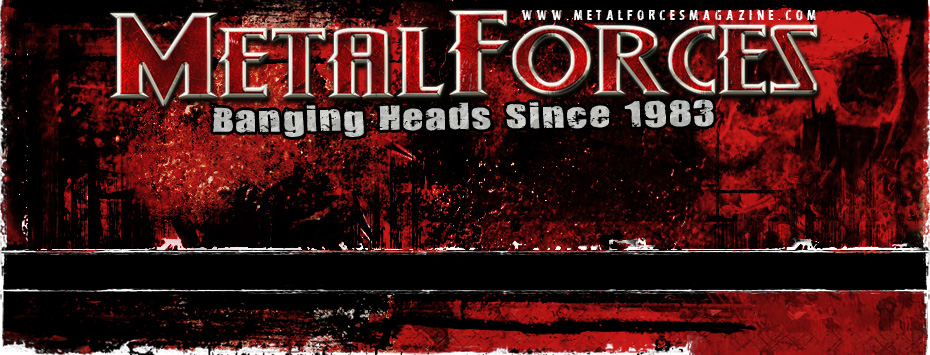
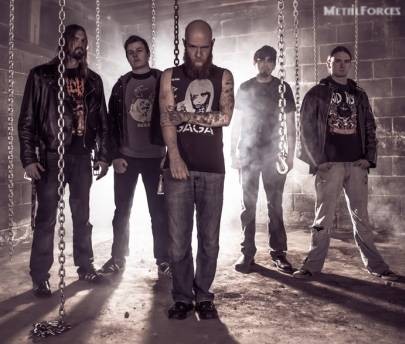
|
Seven-string as well as eight-string guitars are a music trait listeners associate with Allegaeon. “On our EP and our first record, we were just a seven-string band,” the performer highlights. “This is what we did when I joined, and so that was just what we were doing. I don’t think this band ever played six-strings, ever. We were a seven-string band. The band was set up to kind of be an Arch Enemy-like band; that was kind of the main influence when I joined, and that’s what they wanted to do, kind of an Arch Enemy-type thing. It’s morphed over the years, but after we did Fragments Of Form And Function, the idea was to maybe try to write some stuff on eight-string. It gives us a whole other string, so our keys are different. We can do some more interesting things, but then when we did Formshifter, I couldn’t afford an eight-string (laughs).
“I borrowed one, and I hated it. I didn’t write one eight-string song on Formshifter; I completely hated the idea of it, and I hated the sound of it. Ryan wrote three songs on eight-string, and when we recorded them that way, it didn’t sound that bad. On the demos it sounded horrible, but when we actually got in the studio and did it with good recording equipment, it sounded great. That kind of won me over a little bit on the whole eight-string thing, and then we just started kind of being that eight-string band who uses all eight strings – not as an Animals As Leaders type of thing, but just as a whole band – it was cool, because it became a little niche for us so to speak. It just became our gig. I’ll be honest; I don’t really like playing eight strings.
“I think that there’s almost this trend now – especially in America – where the lower you tune, the heavier it is, and I don’t agree with that. I think heaviness is kind of in the notes you choose, and not really what you’re tuned in. The whole tuning thing, that was originally facilitated for singers for what was comfortable for their range. That’s the whole reason it started. When everything started getting lower and lower, it’s gotten to the point where it’s ridiculous. The reason I don’t like it is because if we were just sitting up here playing a different style of music, you can use it appropriately where it’s more rhythmic than melodic shall we say. They can use it to greater effect than we can, but for us, it becomes muddy because we’re playing a whole bunch of notes.
“It’s really based on what kind of style you’re doing; I think it works for others better than it would work for us, so to speak. I mean, we made it work (laughs). We’re doing it, so obviously we’ve had some success with it, but there is that fear that live it’s just gonna turn into mud, and there’s not gonna be a lot of clarity of frequency with us. That’s the real reason I hate it. It’s just fear of not having our music come across as clearly as we picture it, or as it is on the record, if that makes sense. It’s become kind of identifiable with us a little bit though, so we’ll just keep doing it.”
Elements Of The Infinite’s press release describes the outing as ‘Allegaeon’s most realized and mature release to date.’ “That might just be the result of not having as many chefs in the kitchen, as it were,” Greg figures. “When you have one guy writing material, I think it’s easier to have a comprehensive vision of how you want the album to go. When we wrote this, I already knew the track order before we even went into the studio, like ‘This song opens, this song goes here, this song goes here.’ I had it all demoed out from start to finish; all the orchestral stuff I had done, and all the drums were programmed. Every single instrument besides the vocals were demoed – it was meticulous.
“I really spent a lot of time making it meticulous, so we knew pretty much exactly how the album was gonna sound – how it was gonna flow – and that we had never done before. I had done five songs, and Ryan had done five songs. We’d meet and then we’d kind of figure it out afterwards, but now Mike and I just work really good together. Now it’s easy for us to just meet up, and make these decisions way before we ever go to record them.”
A stronger musical partnership seemingly exists between the axeman and Michael than what previously existed between the axeman and Ryan. “It’s just a different way,” he muses. “Ryan and I were more business partners than anything else, I would say. We both had a vested interest in propelling the group. His priorities shifted over the years, whereas Mike is so happy to be here that it’s really just what’s best for us as a group and not what’s best for us as individuals.”
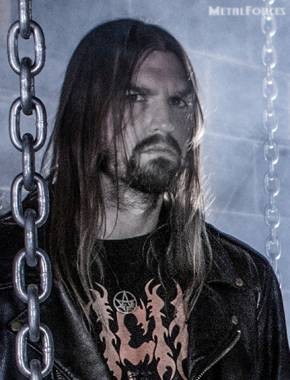
|
Orchestrations for Elements Of The Infinite were composed by Greg in collaboration with Joe Ferris. “How Joe and I got to know each other?,” he queries. “I’m in a couple of other bands, but with this other band that I’m in called Cryogen, their old drummer (Chris Ghigliotty) was a member of the Colorado symphony. Prior to my joining, they had lots of strings and stuff on their album. He had a bit of a drug problem, so he got replaced. I then joined after that, and we got to doing our new record. We did a Kickstarter program to try to fund the record. One of the perks was if we got more capital from fans, then we could hire an orchestra or a string quartet to do some of the arrangements that I had written, and that our old drummer had written for the record. Joe saw that, and hit us up. I think he was just looking for metal bands to work us, because he’s a metalhead but he’s a classical composer – he really wanted to do kind of like Dimmu Borgir-type stuff. We listened to his stuff, and we were blown away. We were like ‘Oh my God. This guy is awesome.’ Right then, I was like ‘Dude, I’m gonna get you for the next Allegaeon record.’
“He was super-stoked. He thought it was gonna be for a future record, even though it was right around the corner. We finished Continuum (November 2013) – that record – and then started handing him tracks for the Allegaeon record. He did a killer job out of the park. Sometimes he would take my ideas and just flesh them out with better sounds, because my MIDI choirs and my MIDI strings are not the greatest. He would just kind of flesh them out, and orchestrate them a little bit more professionally than I would. Some other times then, I was like ‘Hey man, go for it. Here’s the music; write something to accompany this.’ There were a lot of other things where I was just like ‘Hey, just re-amp this’ – some string patch that I wanted in the background, or some choir stuff. He would just run through his programs and put different voices on it, and then it would work great.”
Symphonic traits have always been audible with Allegaeon’s material. “We have kind of our style, and that’s been identifiable with every record that we’ve ever done,” the composer observes. “There’s always been… I’m a huge fan of Devin Townsend’s work, especially in the Devin Townsend Band era when he did Accelerated Evolution (March 2003) and Synchestra (January 2006). If you listen to a lot of the production on those, he had keyboards backing up the guitars and the instruments, and so that’s something that I’ve always been trying to capture – his wall of sound-type thing. We’ve done that on every record that we’ve ever done.
“This record, it’s just a little bit higher in the mix, so it’s really just the next step. It’s just getting bumped up, and making them a little bit more independent. Our new drummer plays to a click, so we can actually program him in. We never did it before because we could never pull it off live, but now we can pull it off live, so it was kind of like ‘Let’s try it.’ Who knows? On the next record it might be way more symphonic, now that we know we can do it. Probably not though, just because the guitars are crazy enough. I can’t imagine making them even more crazy with an orchestra behind them, but you never know.”
Nowadays, lyrical duties are the responsibility of Greg and vocalist Ezra Haynes. “The lyrics are very much kind of a group pot, I would say,” Greg views. “Everybody throws ideas in. In the past, it’s been Ryan, Ezra, and I writing the lyrics. It was a three-way split, and I was always happy to split. I was happy to let Ezra do it. Ryan liked writing lyrics; he wrote a good chunk of the lyrics for his songs as well. For me, I prefer it if Ezra writes them. I don’t like doing it – I consider it a pain in the ass (laughs). I prefer it if he does it. Once again, when there was a change in management, I was like ‘Ezra, just write them all.’ At the same time though, we all have ideas. We are all interested in the same stuff; we love science. It was like ‘Hey dude. What do you think about this?’ I would do a whole bunch of research on the topic, and then I would just send him all of the information.
“‘Gravimetric Time Dilation’, that was something that I had been wanting to do for years – about how mass affects time, gravity, and all that stuff. I just researched it, and gave him all of the source material that I had been researching, and then he wrote it. ‘Biomech II’ was the only one that I wrote with Ezra for this record, because we wrote the first one together. He was like ‘Dude, let’s do that again.’ It was actually a lot of fun sitting in a room with him writing, because there were lots of energy going back and forth, like ‘Hey man. What about this?’ Yeah, ideas and concepts are very much a group concept, but when it comes down to writing it’s more Ezra – unless he wants help, so to speak.”
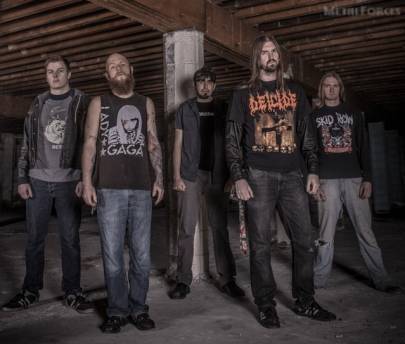
|
‘Biomech II’’s predecessor and fellow cut – ‘Biomech – Vals No. 666’ – was featured on debut record proper Fragments Of Form And Function. “The first one was about a girl in Colorado who had an undeveloped retinal nerve, so she was partially blind,” the axe-slinger tells. “She was a really nice girl named Lacey, and she just loved horses. It scared her though, because she would just see shapes move. You’d have to tell her what it was. Basically in the US, with the last Bush administration, they were cracking down on stem cell research. They had actually cured this problem in China. Basically, based on the legislation passed by our government, she couldn’t get the surgery she needed because it was illegal here. And adversely, there was pressure from right-wing religious organisations who thought that it was against God. We don’t care what they believe, but to make someone suffer because of their beliefs was quite frankly outrageous, and it really angered me. I approached Ezra about this.
“We talked to the girl, and so this was something that was really close to home. I really was angry about this whole situation, and so that was the whole chorus. ‘In the name of god / For the love of god.’ Our response to them was ‘Goddamn you. You don’t tell us what to do. This is better for our people. It’s better for your families.’ What’s wrong with just being nice to people (laughs)? It turned out that our local hockey team raised enough money, though. She was able to go to China, and now she can see. When it came to doing the sequel, they’re now taking stem cells and doing 3D printing, and they’re coming up with replacement organs. It’s becoming a big fad. I just saw an article the other day about the religious backlash starting from the printing of organs, and so that’s what the second ‘Biomech’ is all about; the printing of organs, and the oncoming religious bullshit that’s gonna try to sabotage it.”
On March 9th, 2009, President Barack Obama signed an executive order reversing federal opposition to embryonic stem cell research in the United States. “It’s actually not a problem here any more,” Greg agrees. “I think that he overturned it, if I’m right. We’re not really political or religious (laughs), but these things just popped up.”
Science lyrically unites much of the tracks included on Elements Of The Infinite. “The first song – ‘Threshold Of Perception’ – basically comes from a sociological and scientific viewpoint of a person passing,” the guitarist divulges. “It’s from the point of view where you’re actually told that you’re gonna die, to the chemical release in your brain, and to the acceptance of death. It’s the whole span of just that, of death. It’s basically just an analysis of death, as it were. The second track – ‘Tyrants Of The Terrestrial Exodus’ – is about the evacuation of Earth, and some of the corruption that would go along with it. There are too many people on Earth to evacuate all of us, right? There would be a lottery or whatever it would take, whether it be genetic selection so that the best and brightest of us can carry on the human race. Just the corruption that would go along with it; that’s really what ‘Tyrants’ is about.
“‘Dyson Sphere’ is about building a super-structure around the Sun for energy. ‘The Phylogenesis Stretch’ is about Goldilocks zones, the distance around a Sun where life can exist. ‘1.618’ is about the golden ratio, and how it appears in nature and art and architecture, and just in everything really. ‘Gravimetric Time Dilation’, I talked about that one. ‘Our Cosmic Casket’ is about black holes, and a theoretical what would happen if a black hole approached Earth, and how we’d all be doomed. That’s our cosmic casket, because it affects everyone. ‘Biomech II’, we already talked about that.
“‘Through Ages Of Ice – Otzi’s Curse’ is an ice age tune. We have kind of like a natural disaster on every record; on Formshifter we had ‘From The Stars Death Came’, and that’s the story of an asteroid hitting Earth. When that would then come, it would cause an ice age, so this is the next disaster in the story. ‘The Cleansing’ and ‘The Renewal’ from Fragments Of Form And Function is a part of it, and ‘Nex Of Terra’ from our EP – all part of this one big story. We’ll just really have one song at a time – or two songs, as was the case on Fragments – that will eventually be one whole storyline, and that will play in order for like a DVD down the road. It’s years in the making this whole thing, an idea that Ezra and I had a while ago. ‘Genocide For Praise – Vals For The Vitruvian Man’ is about the Ten Plagues of Egypt; it’s just a sociological breakdown of the motives behind God, and why he would punish a whole bunch of people.”
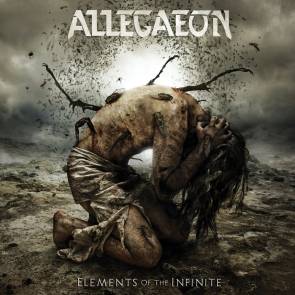
|
Elements Of The Infinite was recorded, mixed and mastered by Dave Otero at Flatline Audio in Colorado between the months of February and April 2014. “Dave is a friend of ours,” Greg enthuses. “He did our EP back in 2008, and then he did Fragments. We were actually in talks with him to do Formshifter, but then Daniel Castleman – who did Formshifter – basically offered us a deal, when our management at the time also managed him. We just flew to California, and did that. After the Tim Lambesis thing went down, the last thing I wanted to do was go back to Lambesis Studios. We wanted to separate ourselves from that whole situation (laughs). Also, he did the Pyrithion thing, so since Ryan and us went our separate ways, we didn’t wanna do that. If we did that, there wouldn’t have been a lot of separation now, would there? It’d just be going parallel. To come back home was kind of a natural thing for the band. I think it was right.
“It’s always nice working at home, instead of flying to another state. I get to sleep in a bed (laughs). I don’t have to sleep on a floor, and I can have a shower every day. You don’t necessarily have that when you’re cross country, and you’ve got to get shit done. Also, you feel less rushed when you’re at home. You can eat and make food, whereas cross country you’re eating out every day – it’s just really expensive. We went back to Dave, though. Dave is very much a hands-on engineer / producer. In the past, we’ve not wanted production in the sense that we’ve not wanted other people’s ideas coming into our music. Dave would always offer those, and so sometimes we would get into fights about parts and stuff that we didn’t want. When I’m only doing five songs, I pretty much slaved over the songs for a long time, and I’m pretty dead set in my ways.
“This time around, I very much wanted his input. I had done way more than I had done on previous records, so I felt my objectivity as far as the songs went was completely just obliterated (laughs). I didn’t know if these songs sucked, or if they were good – I really needed outside help on them. Dave just came in, and he didn’t even change that much. Everything that he suggested, I was like ‘Yeah, let’s try it.’ It just made the songs better. Sometimes he’d be like ‘Hey man. Would you wanna try this?’ I’d be like ‘Dude, I would love to try that. That’d be awesome.’ There was a lot of me seeking out his input too, which was a first. I’d be like ‘Hey man, what do you think about this? I have no clue. Is this good? Is this shit? I don’t know.’ I even write multiple solos for parts. I was like ‘Hey man, I have two solos. You choose which one is better, because I have no clue any more.’ When you write that much material, it’s good to have an outside guy look in, because he was unbiased. Going back to Dave was awesome; I know that we’ll be going back to Dave for a while in the future.”
Elements Of The Infinite’s album title is arguably epic in stature. “Funnily enough, for me, I don’t know if it’s just because I over-think a lot of things, but I like complicated album titles – like Fragments Of Form And Function,” the musician discerns. “That was a total Greg, bonehead thought where I was like ‘Yeah. I really like the way that flows, because it ties in to everything.’ I don’t know. Sometimes this is the way my brain works; sometimes it likes to overcomplicate crap that really doesn’t need to be. When I was just writing demos for the album, I was like ‘Elements Of The Infinite. I really like the sound of that.’
“On a broad spectrum, I think you can tie in all the themes that we have running throughout all of the songs. I really liked it, but it wasn’t supposed to be the name of the record. It’s just what I would label everything in my demos – they’d all be under this thing, and so it just stuck. When it came down to naming the record, everybody was just like ‘Yeah, I like it. I thought that that was what it was.’ It was just kind of like a happy coincidence, or maybe my boneheadedness from day one (laughs). The name just stuck.”
As was the case with previous Allegaeon outings, Elements Of The Infinite’s cover artwork was designed by the London, England-based Colin Marks. “We love Colin, man,” Greg praises. “That guy just does really good work. We loved his work – I think he did some Scar Symmetry covers. We just love that ultra-realist artwork that he does. It’s actually funny, because usually we come up with a concept, present it to him, and then he’ll do it. I was talking to him, because he did the Cryogen work that Joe Ferris was on. We came up with a concept, we gave it to him, and he came back. It’s always way more than you expect – he always kills it. This time I talked to him, but in the meantime he had done the artwork that you see for this other band, and it’s a lot of panels. If you buy the actual physical CD, you’ll see that there’s a lot of panels of art.
“Basically, he did all of these panels, but then the band flaked on him. He was like ‘Dude, this is my favourite piece of artwork I’ve ever done, but this band flaked.’ Basically, he shipped it off to Metal Blade and said ‘Hey, do any of your bands who have an album coming out want this?’ Our rep just forwarded it to us, and it had nothing to with our album. We had a concept and everything, but when we saw it, it was just so awesome that we couldn’t say ‘No.’ We then tried to incorporate some of the artwork into our songs, and that’s where the whole idea for ‘Genocide For Praise’ with the locusts came from – from that artwork.”
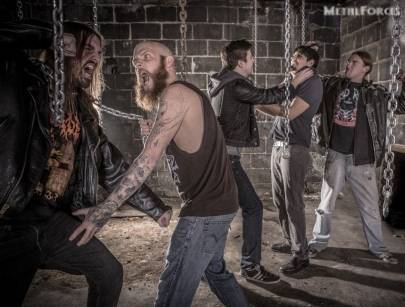
|
A music video was filmed for the track ‘1.618’, the resultant video more light-hearted in tone. “Before that video, we’d had no luck with music videos,” the artist laments. “It was quite clear that we weren’t doing something right, because the whole thing about doing music videos is that it’s everybody’s first source for checking out a band, that they go on YouTube. Our music videos just weren’t taking off, though. The highest one we had was for the first ‘Biomech’; it was six years later, and it had just gotten 100,000 views. It’s now at 200,000 I think because of ‘1.618’, but it’s just taken us so long to get a decent number that we just kind of felt like we suck at this, and that we needed to try a different approach. It was like ‘Hey man, let’s just be ourselves and not badasses.’ We’re not these big, evil death metal dudes at all – we’re not. We’re dorks. We’re really not… Yeah, we’re dorks – that’s the best way to say it.
“When it came down to it, it was like ‘Hey man, let’s just be ourselves; let’s just be jackasses in a video, and try something different.’ We had done all of the videos in-house before; every video we had ever done, we edited. This time, it was like ‘Hey man. Let’s get someone else to do it, because obviously something’s not working,’ so we changed up a whole bunch of stuff. When it came down to filming ‘1.618’, we had the idea of just doing a whole bunch of genres, putting them all in, and just realising how much we suck at all of the genres. You can’t try to be someone else. You can just be yourself, and that was where it came from. It was a lot of just making fun of ourselves, and yeah (laughs). Taking the mickey out of ourselves seems to work, apparently (laughs). We were all so nervous about it, though.
“When we got to ‘Our Cosmic Casket’, it was way more serious. It’s trying to be that badass thing that we’re really not, so in the editing we’re trying to make it a little bit more like ‘1.618’ just to have some consistency, but it was really done out of fear that people were gonna hate ‘1.618’. In hindsight, it didn’t really matter because no-one was watching our videos anyway (laughs).”
Elements Of The Infinite was released on June 20th, 2014 in Germany, Switzerland, and Austria, on the 23rd in the rest of Europe, and subsequently on the 24th in North America, all via Metal Blade Records.
Interview published in June 2014. All 2014 promotional photographs by Matthew Knowles.
